Pankaj Mishra
Masked Transformer for image Anomaly Localization
Oct 27, 2022Abstract:Image anomaly detection consists in detecting images or image portions that are visually different from the majority of the samples in a dataset. The task is of practical importance for various real-life applications like biomedical image analysis, visual inspection in industrial production, banking, traffic management, etc. Most of the current deep learning approaches rely on image reconstruction: the input image is projected in some latent space and then reconstructed, assuming that the network (mostly trained on normal data) will not be able to reconstruct the anomalous portions. However, this assumption does not always hold. We thus propose a new model based on the Vision Transformer architecture with patch masking: the input image is split in several patches, and each patch is reconstructed only from the surrounding data, thus ignoring the potentially anomalous information contained in the patch itself. We then show that multi-resolution patches and their collective embeddings provide a large improvement in the model's performance compared to the exclusive use of the traditional square patches. The proposed model has been tested on popular anomaly detection datasets such as MVTec and head CT and achieved good results when compared to other state-of-the-art approaches.
Fairness based Multi-Preference Resource Allocation in Decentralised Open Markets
Sep 01, 2021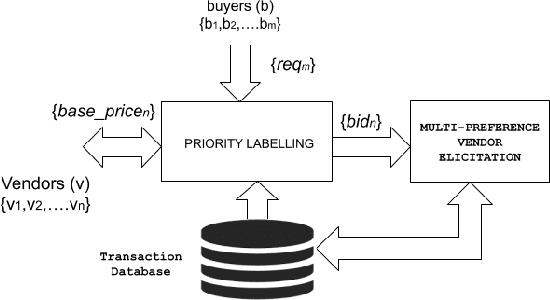
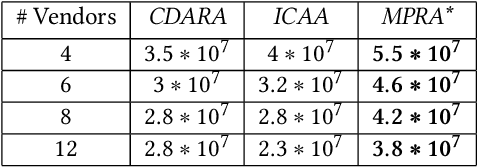
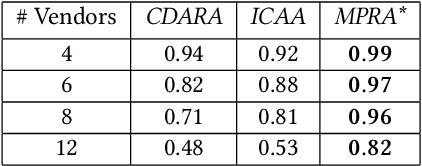
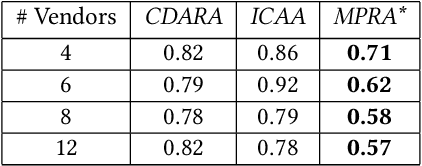
Abstract:In this work, we focus on resource allocation in a decentralised open market. In decentralised open markets consists of multiple vendors and multiple dynamically-arriving buyers, thus makes the market complex and dynamic. Because, in these markets, negotiations among vendors and buyers take place over multiple conflicting issues such as price, scalability, robustness, delay, etc. As a result, optimising the resource allocation in such open markets becomes directly dependent on two key decisions, which are; incorporating a different kind of buyers' preferences, and fairness based vendor elicitation strategy. Towards this end, in this work, we propose a three-step resource allocation approach that employs a reverse-auction paradigm. At the first step, priority label is attached to each bidding vendor based on the proposed priority mechanism. Then, at the second step, the preference score is calculated for all the different kinds of preferences of the buyers. Finally, at the third step, based on the priority label of the vendor and the preference score winner is determined. Finally, we compare the proposed approach with two state-of-the-art resource pricing and allocation strategies. The experimental results show that the proposed approach outperforms the other two resource allocation approaches in terms of the independent utilities of buyers and the overall utility of the open market.
VT-ADL: A Vision Transformer Network for Image Anomaly Detection and Localization
Apr 20, 2021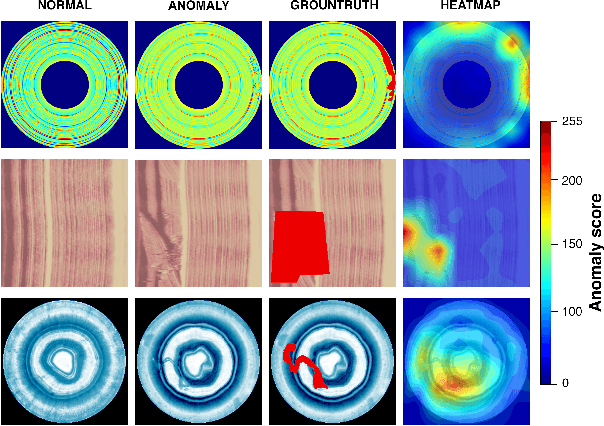

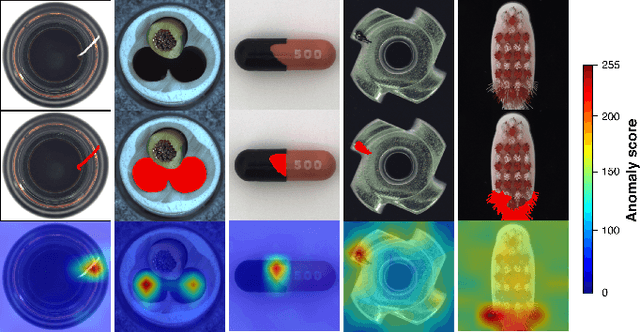

Abstract:We present a transformer-based image anomaly detection and localization network. Our proposed model is a combination of a reconstruction-based approach and patch embedding. The use of transformer networks helps to preserve the spatial information of the embedded patches, which are later processed by a Gaussian mixture density network to localize the anomalous areas. In addition, we also publish BTAD, a real-world industrial anomaly dataset. Our results are compared with other state-of-the-art algorithms using publicly available datasets like MNIST and MVTec.
* 6 Pages, 4 images, conference published paper
Image Anomaly Detection by Aggregating Deep Pyramidal Representations
Nov 12, 2020



Abstract:Anomaly detection consists in identifying, within a dataset, those samples that significantly differ from the majority of the data, representing the normal class. It has many practical applications, e.g. ranging from defective product detection in industrial systems to medical imaging. This paper focuses on image anomaly detection using a deep neural network with multiple pyramid levels to analyze the image features at different scales. We propose a network based on encoding-decoding scheme, using a standard convolutional autoencoders, trained on normal data only in order to build a model of normality. Anomalies can be detected by the inability of the network to reconstruct its input. Experimental results show a good accuracy on MNIST, FMNIST and the recent MVTec Anomaly Detection dataset
Image anomaly detection with capsule networks and imbalanced datasets
Sep 06, 2019



Abstract:Image anomaly detection consists in finding images with anomalous, unusual patterns with respect to a set of normal data. Anomaly detection can be applied to several fields and has numerous practical applications, e.g. in industrial inspection, medical imaging, security enforcement, etc.. However, anomaly detection techniques often still rely on traditional approaches such as one-class Support Vector Machines, while the topic has not been fully developed yet in the context of modern deep learning approaches. In this paper, we propose an image anomaly detection system based on capsule networks under the assumption that anomalous data are available for training but their amount is scarce.
* Published in conference ICIAP 2019
 Add to Chrome
Add to Chrome Add to Firefox
Add to Firefox Add to Edge
Add to Edge